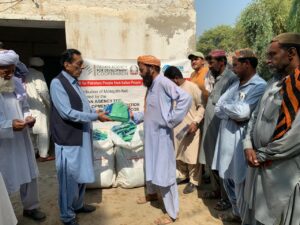The Islamic Republic of Pakistan is the fifth country in the world as population, counting 241,49 millions of citizens1. GDP per capita currently counts 1,536 USD (ranking 160 at global level2), with 38,3% of population living in a multidimensional poverty condition3, with a higher percentage in Khyber Pakhtunkhwa and Baluchistan regions. In 2021, urban population represents 37,44% of the total, for more than 50% living in slums; life expectancy at birth is 66,1 years (68,6 for women, 63,8 for men4). According with HDI – Human Development Index, Pakistan ranks 161 on 191 countries, part of “Low Human Development5” category.
Pakistan is usually considered a “medium-low income” and semi-industrialized country, with 37,5% of its population working in the agricultural sector. Women in agriculture represents 68% of the total women at work. Despite this role played by agriculture, a wrong distribution of arable land and a not-clear management of property rights make difficult for small farmers and their families to make it through poverty condition. Food security is not guaranteed for 42,4% of Pakistani people and 36,7% of children below 5 years are stunted6. Access to clean and potable water is not guaranteed for 35,8% of population, causing diseases to mother and children; before 2025 water availability per capita might decrease to 800m³ while the international standard to define water scarcity is 1,000m³7.
Worst social and economic conditions are in Balochistan, largest region in the country, less developed and less populated (only 10 million people). Regarding gender equality, Gender Gap Global Index 2022 ranked Pakistan 142 on 146 countries; although gender equality is acknowledged by the 1973 Pakistani Constitution, it is poorly guaranteed since discrimination and violence against women are widespread. Adult literacy is growing, especially for women, that in 2010 was 41% and it became 46,9% in 2019; however, in 2022 only 24,6% of women more than 15 years old are working, while men at work are 80,9% of the total8.
In June 2022 heavy rains and large floods hardly hit Pakistan, with relevant human losses and serious damages to public and private infrastructures, jeopardizing local and agricultural ecosystems. Around 33 millions of people have been affected by this catastrophic event, with 8 millions of internal displaced persons. At the end of 2022, consequences were still severe with 600,000 people living in camps, with low access to basic services; at the beginning of 2023, around 20 million people where in need of humanitarian assistance as the country results one of the most affected by extreme natural events (Global Climate Risk Index 2021).
“Pakistan 2025 – One Nation, One Vision” is the programme document published by the Government to define its development strategy, adopting Agenda 2030 and sustainable development goals (SDGs), aiming at enhancing public services and support the most vulnerable communities in the country. Published by MoCC – Ministry of Climate Change, the National Adaptation Plan 2023 goes deeper to specific strategies to cope with climate changes and develop abilities to face dramatic consequences. Supporting farmers to develop new production systems, improve water and natural capital management, promoting urban climate-smart services at federal, provincial and local level, protecting health and education services from continuous climate and economic crisis, NAP 2023 has the relevant goal to collect funds for its ambitious programme, involving international partners with the full support of the Pakistani Ministry of Planning.
1Update August 5, 2023: Microsoft Word - Result announcement Final.docx (pbs.gov.pk)
3 Multidimensional Poverty Approach calculates if an individual is living in one or morepoverty dimensions, according to 5 parameters combined with the intensity of deprivations: (1) Family education conditions, (2) Childhood and youth conditions, (3) Work, (4) Health, (5) Access to basic services. Pakistan scored 0,198 in the last evaluation.
4World Bank Database, Pakistan - Social Development, updated on June 27, 2023
6FAOSTAT, Suite of Food Security Indicators, (July 2023)
7Multiannual Indicative Programme 2021-2027: mip-2021-c2021-8992-pakistan-annex_en.pdf (aics.gov.it)
8 World Bank Database, Pakistan - Social Development, updated on June 27, 2023.





